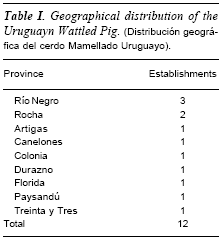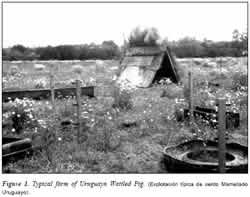- Animal health
- Animal Nutrition
- Genetic and Biodiversity
- Environment and natural resources protection
- Socio-economy in pig production sector
- Quality and food safety
- Animal husbandry and sustainable practices
- Rural Development
Uruguayan wattled pig | Racial study of the Uruguayan wattled pig
In spite of the persistence in Uruguay of pigs belonging to the wattled pig breed, no adequate attention had ever been paid to them. Preliminary information obtained in the census indicates that the Uruguayan Wattled Pigs whilst critical in terms of numbers are widely distributed geographically, living in varying ecosystems and living together with small and medium producers...
Introduction
The race to obtain the typical yields from animal breeds of developed countries has led to the demise of many local productive breeds even though these are often better adapted to the environment, leading to a decline in local agro-biodiversity (GTZ, 2000; Hickman, 1981). Even so, entering the XXI century developing countries possess most of the animal biodiversity. According to FAO (2001) they have altogether almost two thirds of the cattle, 60 percent of pigs, more than half of the sheep and around 95 percent of the goats. Taking into account milk and meat yields, nearly 60 percent of the production comes from the developing countries and 40 percent from developed countries, although production efficiency is greater in the latter (FAO, 1997; FAO and PNUMA, 2000).
But, the production level of the cattle from the developing countries provides better nutrition income and possibilities of work for the families of millions of homes, and a more balanced way to practice agriculture (Poto, 2002; Rodríguez Alcaide et al., 1998). Genetic improvement programmes have typically only been undertaken in developed countries and many of the comparisons between the yield of local and imported breeds have taken place in the industrialized countries, whose main criteria are based on high levels of production, rather than in the conditions present in the developing countries (Telo da Gama, 2002). This has been aggravated by the limited technical documentation available for making decisions about the, best management of zoogenetic resources in such environments (Delgado et al., 2001). Although the local communities usually have ample knowledge of the observable characteristics of their animals, the information documented of most of the productive species is insignificant, (Benítez and Sánchez, 2001; Castro and Fernández, in press; Warsi, 2002).
Uruguay is typical in this respect, it does not base its production on local zoogenetic resources (LZR), although it does preserve them, in spite of the lack of interest shown by the national producers. These LZR are excluded from the local productive systems mainly due to the lack of knowledge of their characteristics, and to the food adaptation of the imported breeds (Fernández, 2000; Rodríguez, 1995). This is also the situation with the UWP. In spite of its persistence, it has never been paid any attention, although the present economic situation and problems in the local pork sector make the search of productive alternatives necessary. The UWP is characterized by its hanging appendages at the base of the neck called wattles. Wattles are an associated morphologic characteristic of ancestries of the Iberian pig (Spanish and Portuguese) and to breeds of the Mediterranean trunk, being uncommon in animals of the Celtic trunk (Castro et al., 2002; Díaz, 1953; Jaume and Alfonso, 2000; Laguna, 1998). This makes the investigation of the UWP interesting, in order to increase the knowledge of its origin, historical evolution and possible kinship with its Mediterranean ancestors.
Materials and method
Within the framework of a global strategy (the complete racial study of the UWP and its productive appraisal) and following the directives of the Global Strategy for the Management of Farm Animal Genetic Resources for FAO (Cardellino, 2002; FAO, 1999; Hammond, 1996) the Uruguayan group from de Ibero American Network on the Conservation of the Biodiversity of the Local Domestic Animals for the Sustainable Rural Development (CYTED Programme, Spain) formed a multidisciplinary team with investigators of the Areas of Animal Genetic Improvement, Genetic and Pig production (Faculty of Veterinary Sciences of Uruguay). This team aims to establish the technical skills required to fortify future activities as well as scientific exchange with other groups that have developed similar experiences. A census of producers based on such experience was carried out to establish the present situation, the origin and the historical evolution of the UWP. A survey for each breeder was designed but afterwards discarded due the reluctance of many of the breeders to give data that would be recorded. This was substituted by a personal interview in the farm and complemented with observation of the breeding unit.
Results

- Number and location of the farms. 12 farms widely distributed geographically from the south-eastern zone (border with Brazil) to the coastal west (border with Argentina) were detected (table I).

- Age of the farmers. A high average age of farmers was recorded (49 years old) which is in agreement with the general aging of the Uruguayan agrarian population.

- Nutritional resources used in pig production. All of the farms utilized residues from the local food-farming industries and harvest residues, as the basic diet for the animals. The use of concentrates was limited to susceptible categories such as piglets and lactating sows. The information obtained shows that the UWP is produced as a complementary agricultural activity, but has a great social meaning, constituting an important economic and nutritious source for the familiar nucleus of the small producer.
Discussion
We should consider that the true value of the genetic diversity may not be adequately reflected in the present options and their pertinent technologies, since animals that are fed on poor valued hays are often better able to survive in difficult or poor environments compared to animals selected for more industrial production environments. As a result and in spite of the little attention that has been paid to the local pig zoogenetic resources in Uruguay, a detailed study (morphological, genetic and productive characterization) as well as an evaluation of their potential productiveness can contribute to: - The design of scientific studies towards the identification and utilization of their important characteristics (for example resistance to certain diseases) or better capacity to assimilate food of lower quality and thus not competing with food destined for human consumption. - Diversify products and create opportunities for the farmer's economical improvement (for example the production of high quality meat products). - Reduce dependency of external foods and to properly weigh the total cost of the foreign genetic materials. - Maintain the ecosystem maximizing the effective use of the resources and the environment, making more stable and sustainable agricultural systems. - Increase the empowerment of farmers and people from the community, encouraging them to participate in research activities and incorporating the local knowledge to the technicians. The future activities of the Team were fortified by the discovery of UWP in an establishment belonging to the Police of Montevideo which represents an important institutional support for the study, utilization and protection of this LZR. An Agreement of Work between the Police of Montevideo and the Red XII-H CYTED was signed up in order to establish a Recovery Centre of the UWP and delineate a Conservational Programme.
References
- Benítez, W. and M. Sánchez. 2001. Los cerdos locales en los sistemas tradicionales de producción. Estudio de producción y sanidad animal, nº 148, FAO. Italy.
- Cardellino, R. 2002. La estrategia mundial para los recursos genéticos. V Congreso de SERGA. 18-20 september. Madrid, Spain.
- Castro, G. y G. Fernández. En prensa. Recursos genéticos porcinos de Uruguay (capítulo). En: Recursos genéticos porcinos de Iberoamérica. Universidad de Córdoba, España.
- Castro, G., G. Fernández, J. Delgado y D. Rodríguez. 2002. Contribución al estudio racial del Cerdo Mamellado Uruguayo. III Simposio Iberoamericano sobre la Conservación de los Recursos Genéticos Locales y el Desarrollo Sostenible. 25-27 november. Montevideo, Uruguay.
- Delgado, J. , C. Barba, M. Camacho, F. Sereno, A. Martínez y J. Vega-Plá. 2001. Caracterización de los animales domésticos en España. Animal Genetic Resources Information, 29: 7-18.
- Díaz, R. 1953. Ganado porcino. Salvat Editores. España. FAO. 1997. Recomendaciones del Grupo Especial de Expertos sobre los Recursos Zoogenéticos. Comité de Agricultura, 14º período de sesiones. 7-11 april. Roma, Italy. FAO. 1999. The global strategy for the management of farm animal genetic resources. Executive brief. FAO and PNUMA. 2000. Peligra la diversidad genética de los animales de granja. Roma, Italy.
- Fernández, G. 2000. Situación de los recursos genéticos domésticos locales del Uruguay. Arch. Zootec., 49: 333-340. España. GTZ. 2000. Gestión de agrobiodiversidad en áreas rurales. Mayo. Alemania.
- Hammond, K. 1996. FAO's global programme for the management of farm animal genetic resources. Proceedings of FAO/IGA Round table on the global management of small ruminants genetics resources. 4-13.
- Hickman, Ch. 1981. No todas las especies amenazadas son salvajes. Revista Ceres/FAO, enero/febrero. Italy. Jaume, J. and L. Alfonso. 2000. The Majorcan Black Pig. Animal Genetic Resources Information, nº 27. FAO/UNEP. Italy.
- Laguna, E. 1998. El cerdo Ibérico en la colonización y en el poblamiento porcino de América. Solo Cerdo Ibérico, n° 1, october. Spain. Poto, A. 2002. Conservación y recuperación de razas animales en peligro de extinción: puntos críticos. V Congreso de SERGA. 18-20 september. Madrid, Spain.
- Rodríguez Alcaide, J.J., A. García Martínez y L. Pardo Sempere. 1998. Conservación de razas autóctonas, economías sostenibles y utilitarismo. Primer Congreso Nacional de SERGA (1997), special number. Spain. Arch. Zootec., 47: 363-369.
- Rodríguez, D. 1995. Proyecto para el desarrollo del Area Suinos de Facultad de Veterinaria de Montevideo. Uruguay.
- Telo da Gama, L. 2002. Critérios demográficos na avaliaçao do estatuto de risco de uma raça. V Congreso de SERGA. 18-20 september. Madrid, Spain. Warsi, W.M.K. 2002. Local livestock for empowerment of rural people. Leisa Magazine, abril.
Comments
CIRAD © 2007 (All rights reserved) - Disclaimer stating - Page updated : 26/04/2007
